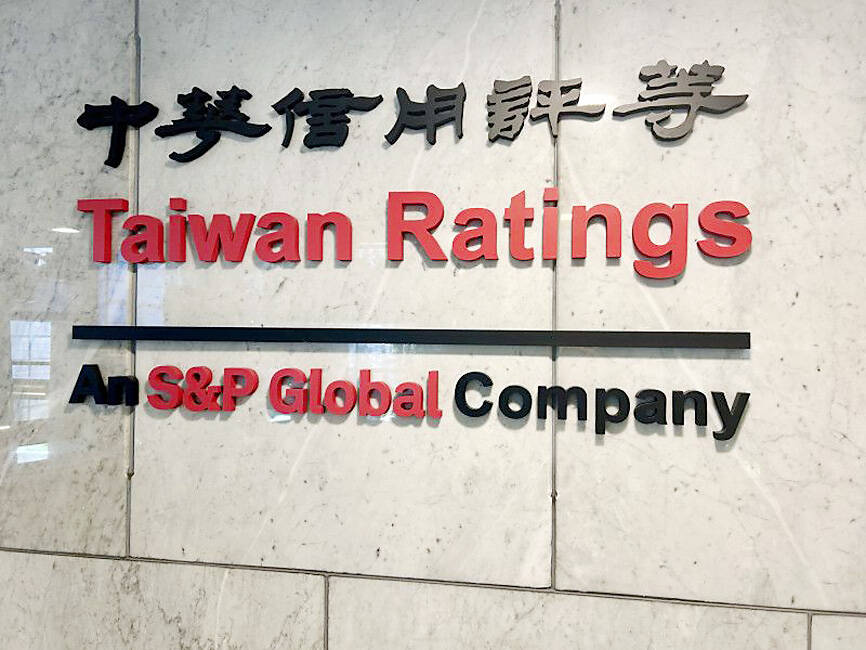Taiwan Ratings Corp (中華信評) has upgraded its GDP growth forecast for Taiwan this year to 3.3 percent from its 2.4 percent estimate in March, citing robust first-half momentum fueled by a resilient technology sector and front-loaded export orders.
Despite the upward revision, the ratings agency yesterday cautioned that the economy would face mounting headwinds in the second half.
Taiwan’s economy remains vulnerable to external shocks due to its trade-dependent structure and exposure to global supply chains, Taiwan Ratings credit analyst Joe Lin (林顯勍) said at a news conference in Taipei.

Photo: Wu Hsin-tien, Taipei Times
“Export strength seen in the first half is likely to taper off as clients complete inventory restocking and early shipments intended to get ahead of anticipated US tariff hikes begin to fade,” Lin said.
The New Taiwan dollar’s sharp appreciation could also erode local exporters’ profit margins and reduce their competitiveness across tech supply chains, Lin added.
The local currency’s exchange rate against the US dollar is projected to stabilize at about NT$30 this year, as tariff-related volatility subsides, he said.
Washington is expected to announce further tariff details this week, as a 90-day waiver ends, a development that could influence Taiwan’s export performance.
Outside the technology sector, performance across traditional industries is mixed.
Taiwan Ratings credit analyst Beatrice Chen (陳靜儀) said the chemicals industry remains under pressure, with recovery lagging earlier forecasts.
China’s stimulus efforts are unlikely to provide meaningful relief, given underlying structural demand weaknesses, she added.
Steelmakers are also under strain, as subdued global demand, persistent overcapacity in China and rising exports weigh on prices and profitability of Taiwanese peers, Chen said.
In contrast, the cement industry is showing signs of stabilization. Improved pricing and production discipline in China, and lower coal costs are helping shore up margins, she said.
Steady income from non-cement operations and overseas businesses is also supporting cash flow stability, she added.
As for financial services, insurers are facing challenges amid market volatility.
Taiwan Ratings credit analyst Andy Chang (張書評) said that average returns on assets are expected to decline this year.
However, enhanced hedging strategies and regulatory support are likely to preserve the sector’s profitability, he said.
Life insurance premium growth is projected to be about 6 percent this year, driven by demand for US dollar-denominated, interest-sensitive and participating policies, Chang said.

Taiwan Semiconductor Manufacturing Co (TSMC, 台積電) last week recorded an increase in the number of shareholders to the highest in almost eight months, despite its share price falling 3.38 percent from the previous week, Taiwan Stock Exchange data released on Saturday showed. As of Friday, TSMC had 1.88 million shareholders, the most since the week of April 25 and an increase of 31,870 from the previous week, the data showed. The number of shareholders jumped despite a drop of NT$50 (US$1.59), or 3.38 percent, in TSMC’s share price from a week earlier to NT$1,430, as investors took profits from their earlier gains

In a high-security Shenzhen laboratory, Chinese scientists have built what Washington has spent years trying to prevent: a prototype of a machine capable of producing the cutting-edge semiconductor chips that power artificial intelligence (AI), smartphones and weapons central to Western military dominance, Reuters has learned. Completed early this year and undergoing testing, the prototype fills nearly an entire factory floor. It was built by a team of former engineers from Dutch semiconductor giant ASML who reverse-engineered the company’s extreme ultraviolet lithography (EUV) machines, according to two people with knowledge of the project. EUV machines sit at the heart of a technological Cold

Taiwan’s long-term economic competitiveness will hinge not only on national champions like Taiwan Semiconductor Manufacturing Co. (TSMC, 台積電) but also on the widespread adoption of artificial intelligence (AI) and other emerging technologies, a US-based scholar has said. At a lecture in Taipei on Tuesday, Jeffrey Ding, assistant professor of political science at the George Washington University and author of "Technology and the Rise of Great Powers," argued that historical experience shows that general-purpose technologies (GPTs) — such as electricity, computers and now AI — shape long-term economic advantages through their diffusion across the broader economy. "What really matters is not who pioneers

TAIWAN VALUE CHAIN: Foxtron is to fully own Luxgen following the transaction and it plans to launch a new electric model, the Foxtron Bria, in Taiwan next year Yulon Motor Co (裕隆汽車) yesterday said that its board of directors approved the disposal of its electric vehicle (EV) unit, Luxgen Motor Co (納智捷汽車), to Foxtron Vehicle Technologies Co (鴻華先進) for NT$787.6 million (US$24.98 million). Foxtron, a half-half joint venture between Yulon affiliate Hua-Chuang Automobile Information Technical Center Co (華創車電) and Hon Hai Precision Industry Co (鴻海精密), expects to wrap up the deal in the first quarter of next year. Foxtron would fully own Luxgen following the transaction, including five car distributing companies, outlets and all employees. The deal is subject to the approval of the Fair Trade Commission, Foxtron said. “Foxtron will be